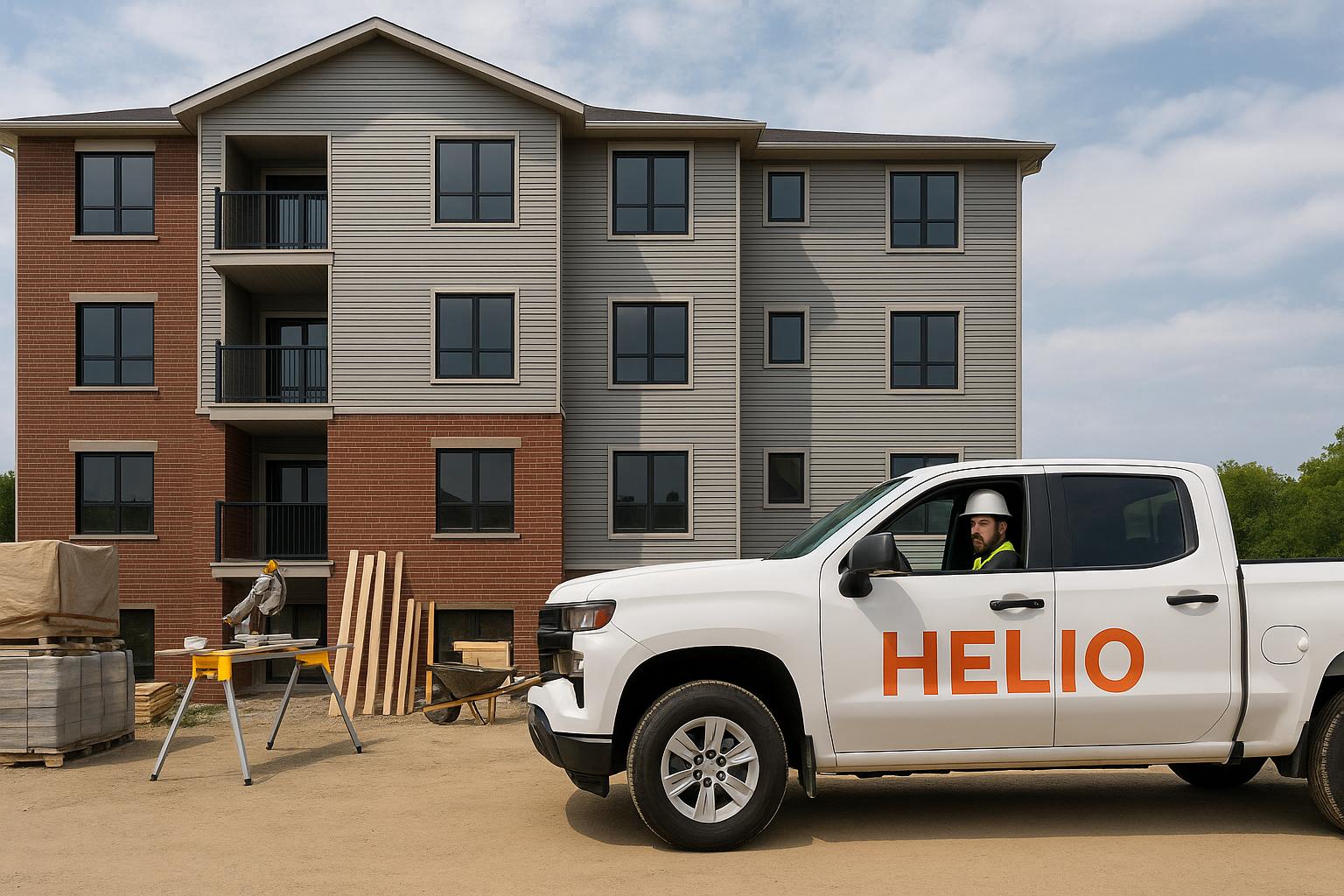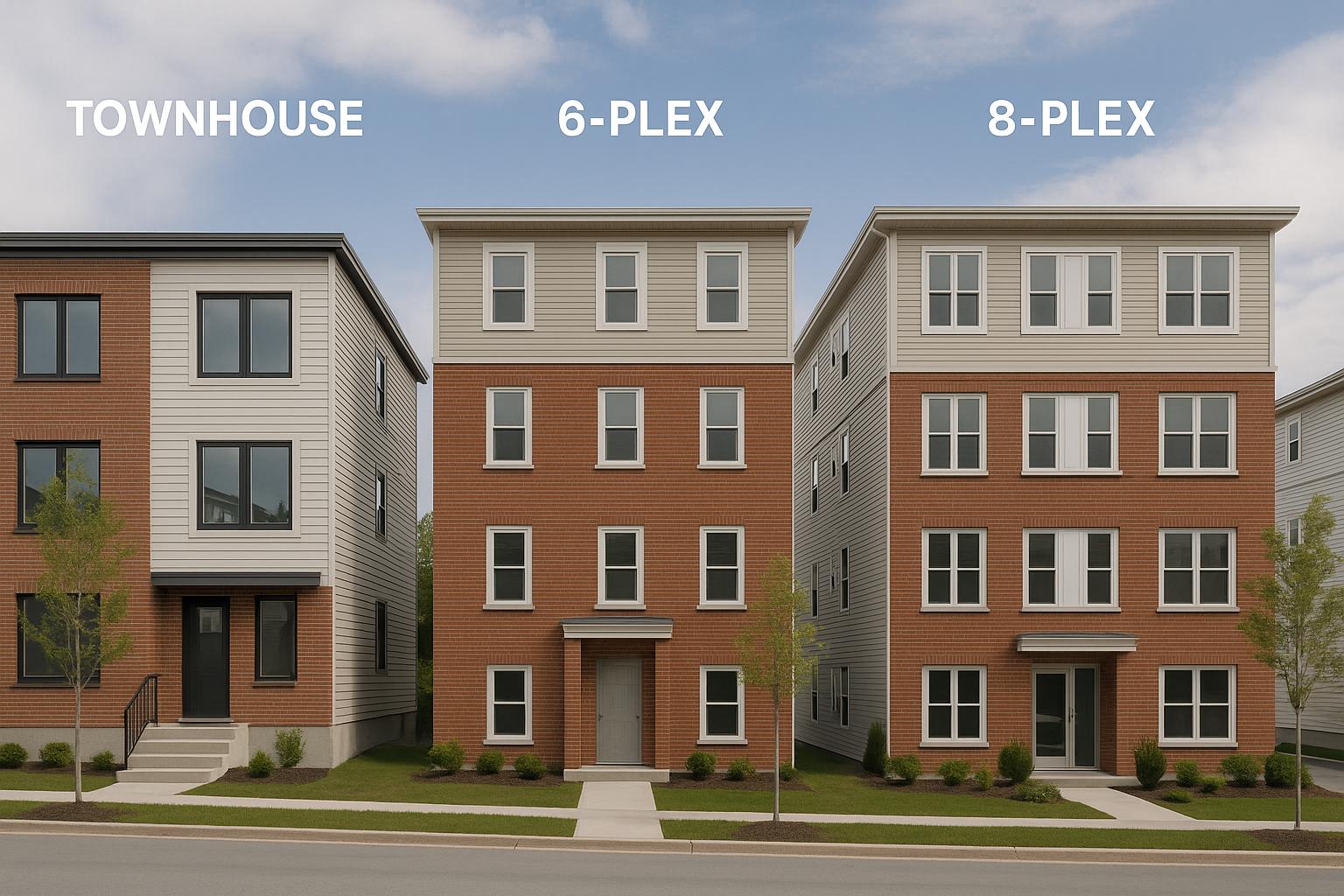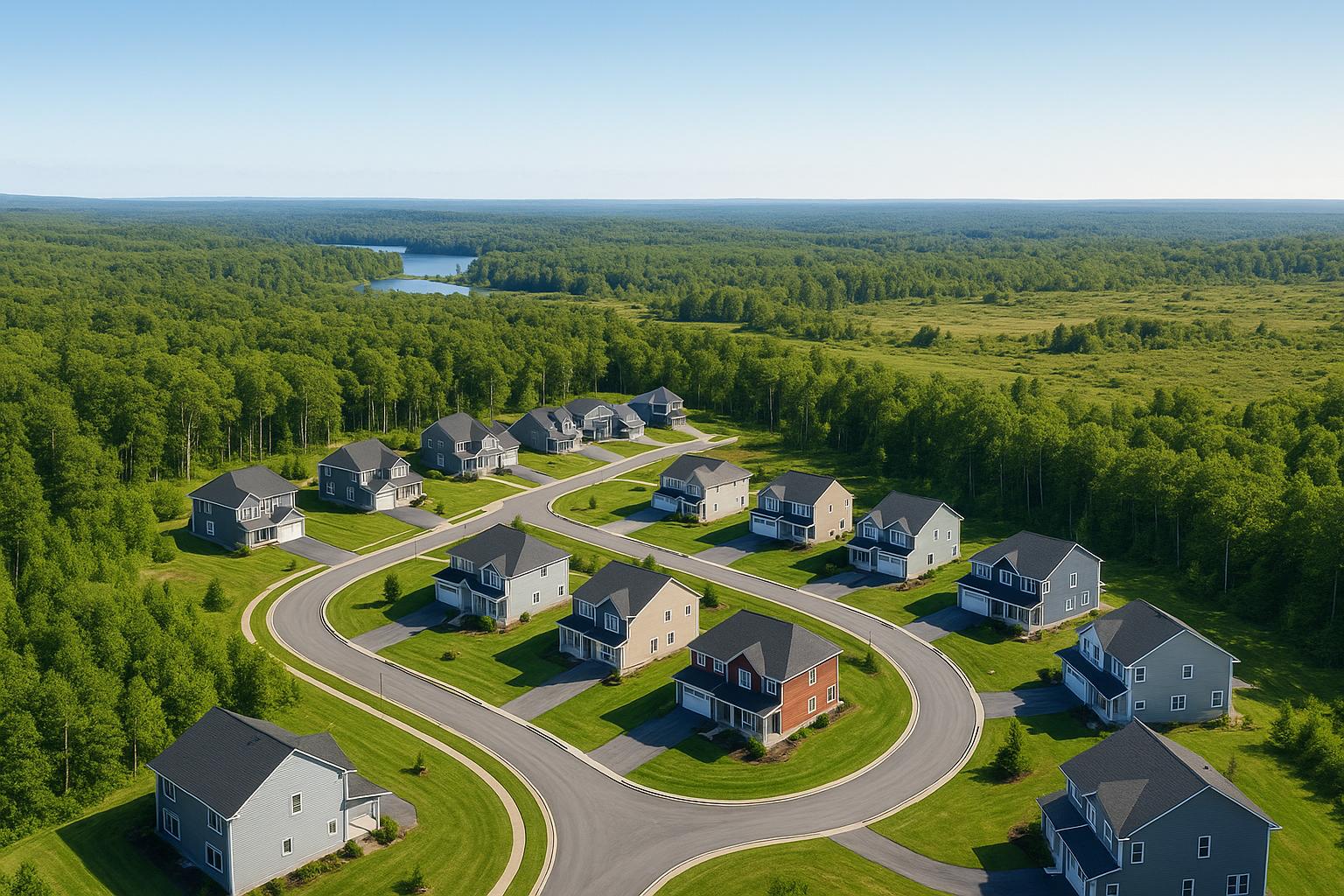Halifax’s coastal climate is tough on buildings. Freeze–thaw cycles, salt-laden winds, and heavy snow can damage exteriors and increase maintenance costs. Smart planning and the right materials can extend the life of your property while improving tenant comfort. Here’s what you need to know:
- Street Trees: Salt-tolerant species like red maple and honey locust thrive in Halifax. Proper spacing, planting depth, and maintenance are critical for long-term health.
- Canopies: Use durable materials like aluminium or tempered glass. Design for snow loads, wind resistance, and effective drainage to handle Halifax’s harsh weather.
- Materials: Opt for marine-grade finishes and corrosion-resistant hardware to combat salt spray and freezing conditions.
- Construction: Integrated design-build methods save time and money by ensuring all teams work together from the start, avoiding delays and costly errors.
- Maintenance: Regular seasonal care, salt protection, and routine inspections keep your property in top shape and prevent long-term damage.
Planning with Halifax’s unique conditions in mind ensures your property stays durable, safe, and visually appealing.
Architect Designs A Coastal Home That Blends Into The Landscape (House Tour)
Evaluating Site Climate and Local Conditions
When planning construction in Halifax, it's crucial to consider the city's coastal climate and how it impacts trees, canopies, and materials. Local weather patterns, such as heavy wind-driven rain and salt spray, play a significant role in material durability and the performance of building façades. Understanding these factors lays the groundwork for design strategies discussed later.
Halifax Weather Risks and Building Impact
Halifax's weather poses unique challenges for buildings. Wind-driven rain can harm cladding, while salt spray speeds up metal corrosion. Choosing the right construction materials and methods is key to addressing these challenges.
At Queen's Marque (completed March 2023), designers opted for hand-patinated muntz metal panels, known for their resilience in maritime conditions. They also used sandstone, which revealed sealant issues when it darkened after getting wet[1].
Site Orientation and Local Climate Patterns
The way a building is oriented affects its exposure to Halifax's weather and marine conditions. By analysing a structure's positioning, designers can make smarter decisions about façade treatments and window placements, ensuring the building can better withstand the elements over time.
Halifax Regional Municipality Rules and Building Codes

Understanding site conditions also requires familiarity with local regulations. Halifax Regional Municipality (HRM) building codes, including urban forestry bylaws and standards for snow loads, setbacks, and accessibility, play a critical role in shaping design choices. Early engagement with HRM's planning department helps ensure that designs meet these requirements while maintaining durability.
A thorough site assessment allows for integrated design solutions that are well-suited to Halifax's challenging climate, ensuring the selection of resilient trees, canopies, and materials.
Choosing and Planting Street Trees for Halifax
When it comes to Halifax’s coastal climate, picking the right street trees is just as important as choosing the materials and design for your property. The right trees not only withstand salt spray and high winds but also enhance curb appeal and improve the overall streetscape.
Best Tree Species for Halifax's Climate
Red maple (Acer rubrum) is a standout choice for Halifax. Known for its ability to handle salty air and strong winds, this native tree is a reliable option. Its deep roots make it resistant to wind damage, and it grows to a height of 15-20 metres, offering stunning autumn colours that tenants and visitors alike will enjoy.
Honey locust (Gleditsia triacanthos) is another excellent option. Thornless varieties are ideal for urban spaces, providing filtered shade without the upkeep of dense canopies. These trees thrive in poor, urban soils and are rarely affected by storm damage, making them a practical choice for Halifax.
Little-leaf linden (Tilia cordata) offers dense shade and performs well in the city’s variable moisture conditions. Its heart-shaped leaves and fragrant flowers add charm to any property, while its compact growth habit requires minimal pruning.
Freeman maple (Acer × freemanii) combines the strengths of red and silver maples. It grows faster than red maple and has better salt tolerance than silver maple, making it well-suited for Halifax’s clay soils. Plus, it delivers reliable fall colours.
Avoid planting Norway maple and silver maple. Norway maples struggle with salt damage in Halifax, while silver maples are prone to branch breakage during storms, leading to higher maintenance costs.
Once you’ve chosen the right species, proper planting techniques will help ensure your trees thrive in Halifax’s challenging conditions.
Tree Planting and Care Methods
Spacing matters when planting trees. Large species like red maple need to be planted at least 8 metres from buildings and spaced 12 metres apart along the street. Smaller trees, such as honey locust, can be planted closer together, with 6-8 metres between them.
Planting depth is critical for healthy growth. The root flare - where the trunk widens into the roots - should sit at ground level. Dig planting holes twice as wide as the root ball and as deep as the root ball’s height. Since Halifax’s clay soils tend to compact, breaking up the sides of the hole helps roots expand.
Mulch helps regulate temperature and moisture. Spread 7-10 centimetres of organic mulch around the base of the tree, but keep it 15 centimetres away from the trunk to avoid pests. Wood chips are a better choice than bark mulch in Halifax’s wet climate.
Watering and pruning are key, especially for young trees. Deeply water new trees twice a week during dry spells for their first two growing seasons. Prune during dormancy to remove weak branches and encourage strong growth. While mature trees can often rely on rainfall, supplemental watering during droughts helps maintain their health and appearance.
Avoiding Conflicts with Sidewalks and Utilities
Proper placement is just as important as species selection when planting trees in urban areas.
Underground utilities can pose hidden risks. Before digging, call Nova Scotia One-Call at 1-800-DIG-SAFE to have utility lines marked for free. This step helps avoid damaging water, power, and telecommunications lines.
Sidewalks and root systems need careful planning. Large trees should be planted at least 2 metres from sidewalks to prevent root heaving. For smaller species, like honey locust, keep a distance of 1.5 metres. Installing root barriers during planting can help guide roots away from hardscaping.
Overhead space is another consideration. Maintain at least 4.5 metres of clearance above sidewalks and 5.5 metres above streets. Compact species, such as little-leaf linden, are better suited for planting near power lines, reducing the need for frequent pruning.
Drainage is crucial in Halifax’s clay soils. Avoid planting large trees within 3 metres of building foundations to prevent structural issues. Position trees to intercept surface runoff while avoiding areas where standing water could harm roots or nearby structures.
Salt exposure can be a challenge. Plant salt-tolerant species within 6 metres of roadways, and consider installing barriers early on to protect against winter road salt.
Building Weather-Resistant Canopies and Entryways
A thoughtfully designed canopy not only boosts the visual appeal of your property but also provides reliable protection against Halifax's tough coastal weather. By selecting durable materials and employing smart construction practices, you can create an entrance that stays secure and welcoming, even in challenging conditions. This section explores canopy options that align with resilient tree choices and tailored material planning.
Canopy Materials and Construction Types
Halifax's coastal climate demands materials that can handle salt air, strong winds, and fluctuating temperatures. Here’s a breakdown of popular choices:
- Aluminium Frames: Lightweight yet sturdy, aluminium is a cost-effective option that resists salt corrosion, making it ideal for the coast. Its lighter weight also simplifies installation with existing structures.
- Steel Frames: Better suited for larger canopies, steel offers strength but requires protective coatings to prevent salt-induced corrosion.
- Tempered Glass Panels: For a sleek, modern look, tempered glass provides dependable weather protection. However, it requires regular cleaning to manage salt deposits and maintain clarity.
- Polycarbonate Sheeting: A practical alternative to glass, polycarbonate offers excellent impact resistance and insulation, making it a good choice for areas prone to falling debris or ice.
- Fabric Canopies: While visually appealing, fabric canopies are less practical in Halifax due to salt spray, UV exposure, and freezing conditions, which can lead to frequent replacements and higher maintenance costs.
- Green Roof Canopies: These eco-friendly options are gaining attention for their environmental benefits. However, they need precise engineering to handle the extra weight of soil and plants, as well as proper drainage systems.
Canopy Size and Placement Planning
The size, height, and placement of a canopy play a crucial role in its functionality and appearance. A well-designed canopy should extend far enough to shield against wind-driven rain while maintaining a welcoming entrance. Ensuring the right height and slope is essential for proper drainage and to minimise ice buildup.
Incorporating built-in gutter systems can help manage water runoff, protecting walkways and the building's foundation. Wind considerations are also critical - features like windbreaks or side panels can counteract uplift forces. For practical and aesthetic reasons, using smaller canopies over individual entrances might be preferable to a single large structure, as this approach simplifies maintenance and avoids a bulky appearance.
Meeting Snow Load and Wind Requirements
Halifax's winter weather demands canopies that can handle heavy snow and strong winds. Proper anchoring is essential to prevent wind uplift, while robust structural connections are key to avoiding water infiltration and ensuring long-term durability.
Engineered designs should account for snow loads, wind drifts, and deflection limits to protect both the canopy and its supporting framework. Professional engineering support is often necessary, especially for larger or more complex projects. Local building codes typically require engineered drawings, and early collaboration with building officials can help streamline inspections and approvals.
Adding snow guards or ice management systems can further enhance safety by reducing the risk of falling ice. These integrated features not only improve safety but also make maintenance easier, ensuring the canopy performs well over the long term.
sbb-itb-16b8a48
Choosing Materials for Halifax's Coastal Climate
When it comes to Halifax's coastal challenges, picking the right exterior materials isn't just a preference - it's a necessity. The salty air here is no joke, speeding up corrosion by as much as 10 times compared to non-coastal environments [2]. Add in ocean spray, freezing and thawing cycles, and those relentless winds, and you’ve got a recipe for wear and tear. The goal? Protect your investment and keep maintenance costs in check.
Corrosion-Resistant Hardware and Finishes
Halifax Harbour’s salty breeze creates tough conditions for metal components. To combat this, opt for Type 316 stainless steel fasteners or other marine-grade options - they’re built to handle the harsh environment. Hot-dip galvanized hardware can work too, but keep in mind that minimally galvanized materials won’t hold up near the shoreline.
For exposed metal parts like railings or canopy frames, go with marine-grade coatings. Yes, these coatings might cost more upfront, but they’ll outlast standard paints, making them a smart long-term choice. Another great option is aluminum hardware with anodized finishes, which naturally resists corrosion.
If you’re unsure, take a look at nearby structures to see how different materials have fared over time. Properties closer to the water often face harsher corrosion than those further inland. This insight can help you make informed decisions about materials and budget based on your specific location.
Using Integrated Design-Build Construction
Halifax's challenging climate - with heavy snow loads and constant salt exposure - demands a construction process that leaves no room for error. When creating weather-resistant frontages in the area, the method of construction is just as crucial as the materials you choose. Disjointed construction processes often lead to coordination issues, cost overruns, and delays, all of which are amplified by Halifax's harsh conditions. An integrated design-build approach, however, can simplify the process and ensure long-lasting, resilient results.
Multiple Contractors vs. Single-Team Construction
Traditional construction methods often involve separate teams of architects, engineers, landscapers, and contractors. This fragmented setup can increase project timelines by as much as 150% and significantly drive up costs.
For example, an architect might design canopies without consulting a structural engineer about Halifax's snow load requirements. Meanwhile, a landscaper could plant trees that interfere with foundational work. The general contractor might blame delays on the engineer, and the canopy installation gets postponed due to poor coordination. These inefficiencies often result in 30–60% cost overruns, with 8-month projects stretching to 18 months or more.
In contrast, an integrated design-build approach brings planners, architects, engineers, and construction teams together under one umbrella. This unified team works collaboratively from the start. The structural engineer is already aware of the canopy designer's snow load plans, and the landscaping team coordinates tree placements with utility routing from the outset. Everyone is aligned with the same timeline and budget, eliminating many of the inefficiencies seen in traditional methods.
The benefits are clear: integrated design-build projects save an estimated $47,000 in coordination costs and reduce project durations by up to 50%. That’s money and time that can be redirected toward higher-quality materials or additional weather-resistant features for Halifax’s demanding environment.
Timeline and Quality Commitments
Beyond simplifying project management, the integrated model ensures strict adherence to timelines and quality standards.
Traditional construction often relies on vague estimates, leaving property owners exposed to delays that can push projects into Halifax's unforgiving winter months. Integrated design-build teams, on the other hand, offer firm guarantees. For instance, they commit to completing projects within six months, with penalties of $1,000 per day for delays. Advanced scheduling tools further minimize the risk of setbacks.
Quality is another area where integrated teams excel. Instead of relying on inconsistent standards from multiple contractors, these teams implement triple quality verification systems. A Professional Engineer conducts five inspections throughout the project, and property owners can bring in their own inspector for an additional layer of assurance. To back it all up, integrated projects come with comprehensive 2-year warranties covering all construction work - unlike the piecemeal warranties typically offered by separate contractors.
Fixed-price contracts are another advantage. Unlike cost-plus pricing, where overruns fall on the property owner, integrated builders lock in costs before breaking ground. This approach protects your investment and ensures no unpleasant surprises.
Real-time project portals provide daily photo updates, keeping property owners informed and ensuring that every detail is executed correctly. In a climate as demanding as Halifax’s, this level of accountability prevents the blame-shifting that often arises when weather-related issues occur. With one team responsible for the entire project, you get a streamlined process and a frontage built to withstand whatever Halifax throws at it.
Long-Term Maintenance and Property Protection
Keeping your property frontage in good shape requires consistent upkeep, especially in a place like Halifax, where coastal storms, freeze–thaw cycles, and salt corrosion are constant challenges. Regular maintenance not only keeps things looking sharp but also ensures tenant satisfaction and helps with unified warranty claims.
Seasonal Care for Trees and Canopies
Halifax’s unpredictable weather makes it crucial to maintain trees and canopies throughout the year. Street trees endure winter salt exposure and summer droughts, while canopies must handle strong winds and heavy snow.
- Spring: Inspect for winter damage, such as broken branches or loose canopy connections. This is the time to prune trees and clear canopy drainage systems to avoid ice buildup.
- Summer: Focus on tree health with deep watering for young trees and clean canopy surfaces to prevent wear and tear. Regularly check mounting hardware for any issues caused by temperature changes.
- Fall: Prepare for winter by pruning weak branches and clearing gutters and downspouts. Apply protective treatments to metal hardware to guard against salt damage.
- Winter: Keep an eye on snow and ice accumulation on canopies. Clear them promptly to avoid overloading. While building codes set minimum standards, regular clearing is key to preventing damage.
Seasonal maintenance like this not only keeps things in top shape but also protects against salt and de-icing damage, as outlined below.
Salt and De-Icing Damage Prevention
Road salt, calcium chloride, and other de-icing chemicals can wreak havoc on both vegetation and building materials over time. Taking proactive steps can mitigate these effects.
- Tree Protection: Use barriers like burlap screens or plastic sheeting during heavy salting periods. During winter thaws, flush the root zones with fresh water to dilute salt buildup.
- Material Protection: Clean stainless steel hardware regularly and check aluminum canopy frames for signs of galvanic corrosion, especially where different metals meet. Applying protective coatings before winter adds an extra layer of defence.
- Drainage Management: Prevent salt from pooling around trees and structural elements by directing meltwater away from sensitive areas. Install measures to redirect salt spray in high-traffic zones.
Come spring, flush out affected areas, amend soil as needed, and inspect metal surfaces for any damage to protective coatings. This will help maintain the structural integrity of your property.
Warranty Coverage and Regular Inspections
To handle Halifax’s tough climate, unified maintenance and warranty programs are invaluable. They provide a safety net, especially since traditional construction methods often lead to fragmented warranties that leave gaps when weather-related damage occurs.
- Comprehensive Coverage: Ensure your warranty covers all major frontage elements under a single agreement. This minimizes disputes over responsibilities when damage happens.
- Routine Inspections: Schedule inspections with professionals in spring (post-winter) and fall (pre-winter) to catch issues early and avoid costly repairs.
- Detailed Records: Keep thorough documentation of maintenance activities, including digital records and timestamped photos. These are essential for warranty claims and help maintain property value.
- Emergency Protocols: Have a plan in place with trusted contractors for quick repairs after severe weather events.
With regular maintenance and a well-managed warranty program, your property frontage can withstand Halifax’s demanding environment while maintaining its appeal and durability.
Conclusion: Building Frontages That Handle Halifax Weather
Creating building frontages that can withstand Halifax’s challenging climate is about more than just durability - it’s about crafting rental properties that balance tenant comfort with strong financial returns. The difference between a property that thrives and one that becomes a financial drain often comes down to how well the construction process is managed from the start. This aligns with the integrated approach highlighted earlier.
Halifax’s local design-build development companies showcase the advantages of this method. Projects like the George Residence on Pepperell and the Press Block highlight the importance of prioritizing long-term resilience over short-term gains. These developments succeeded because their creators planned to hold onto their assets, ensuring meticulous planning and attention to every detail.
Another example is the Stanley Street Homes project, a collaboration with Andy and Kerry Lynch. This project demonstrated how streamlined construction phases can save both time and labour - critical factors when working against Halifax’s unpredictable weather.
As previously mentioned, fragmented construction methods often lead to delays and extra expenses, as property owners juggle multiple contractors. By contrast, an integrated design-build approach brings planners, architects, engineers, and construction teams together under one roof. This ensures clear communication and smooth workflows, avoiding common setbacks and inefficiencies.
The financial benefits speak for themselves. Properties built using this cohesive system typically achieve annual returns of 12–20% and command rental rates between $1,950 and $2,100 per unit. Additionally, these buildings require less upkeep, as they are specifically designed to handle Halifax’s coastal environment, a testament to the coordination and quality control that comes with this approach.
FAQs
How can I maintain street trees and canopies to withstand Halifax's tough climate?
To keep street trees and canopies thriving in Halifax's tough coastal climate, a few key practices can make all the difference. Start with regular pruning - removing weak or damaged branches not only encourages healthier growth but also helps trees withstand storms. Aim for a pruning cycle of about every seven years for most species.
Adding mulch around the base of trees is another smart move. Mulch locks in moisture, shields roots, and provides insulation against extreme weather. It’s also important to inspect canopies regularly, especially after storms, to spot damage and trim branches that could pose risks during high winds.
By sticking to these straightforward steps, you can help your trees withstand Halifax's challenging weather while promoting their long-term health and stability.
How does a design-build approach improve construction in Halifax’s challenging coastal climate?
A design-build approach makes tackling construction in Halifax’s coastal climate much more straightforward by merging the design and construction phases into one smooth process. This teamwork approach ensures that features like elevated foundations and tough, weather-resistant materials are planned from the start to handle challenges like strong winds, heavy snow, and coastal flooding.
By improving communication and cutting down on delays, this method helps keep costs under control while tailoring construction to Halifax’s specific weather demands. The outcome? A faster process and sturdy, weather-ready designs that not only boost tenant comfort but also add lasting value to the property.
What materials are best for building durable frontages in Halifax's challenging coastal climate?
In Halifax's challenging coastal environment, where salt-laden winds and frequent freeze-thaw cycles are the norm, certain building materials stand out for their durability. Fibre cement siding, stone, high-impact metal, and reinforced concrete are excellent options. These materials are specifically engineered to resist corrosion, moisture damage, and temperature swings, ensuring they hold up over time with minimal upkeep.
Choosing these sturdy materials not only safeguards your property but also boosts its visual appeal and market value - an especially wise decision for multi-unit rental properties in Halifax's demanding climate.
Related Blog Posts
- Building on the Nova Scotia Coast: How to Design and Construct Durable Seaside Home
- Top 5 Home Design Trends in Halifax for 2025 (and How to Incorporate Them)
- Designing Your Nova Scotia Coastal Dream Home: Embrace the Ocean, Resist the Elements
- Building Resilient Coastal Homes in Nova Scotia: Storm-Proof and Future-Ready



